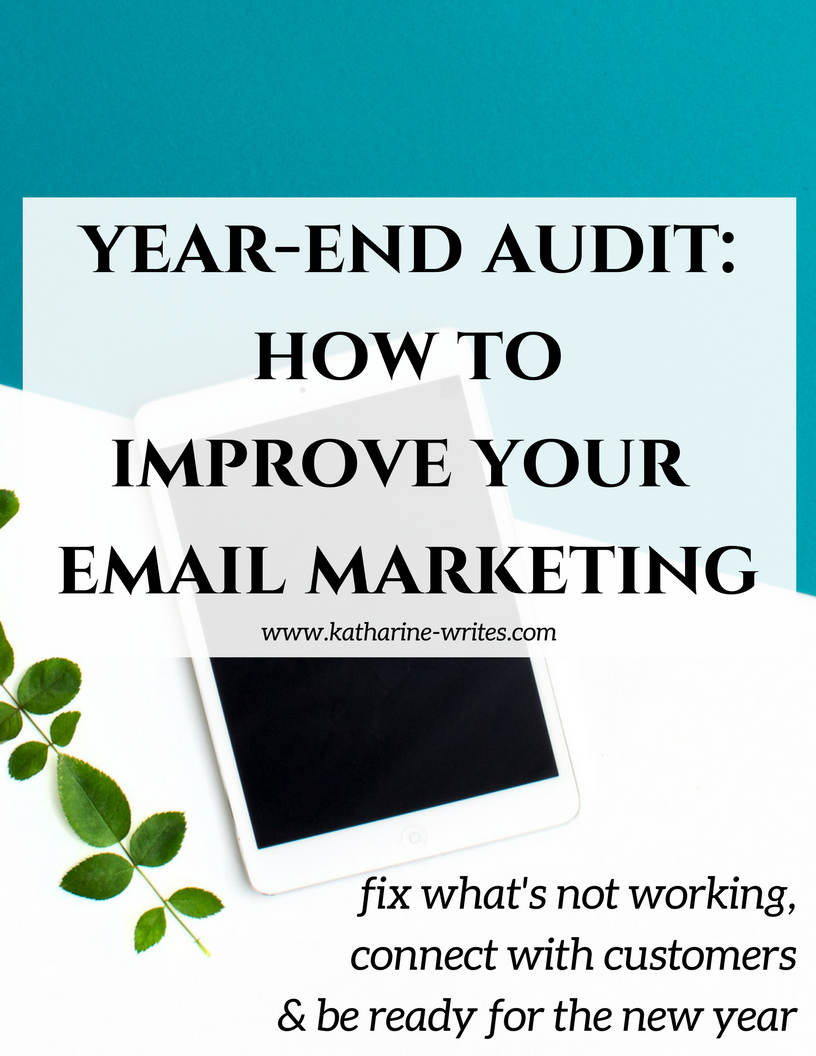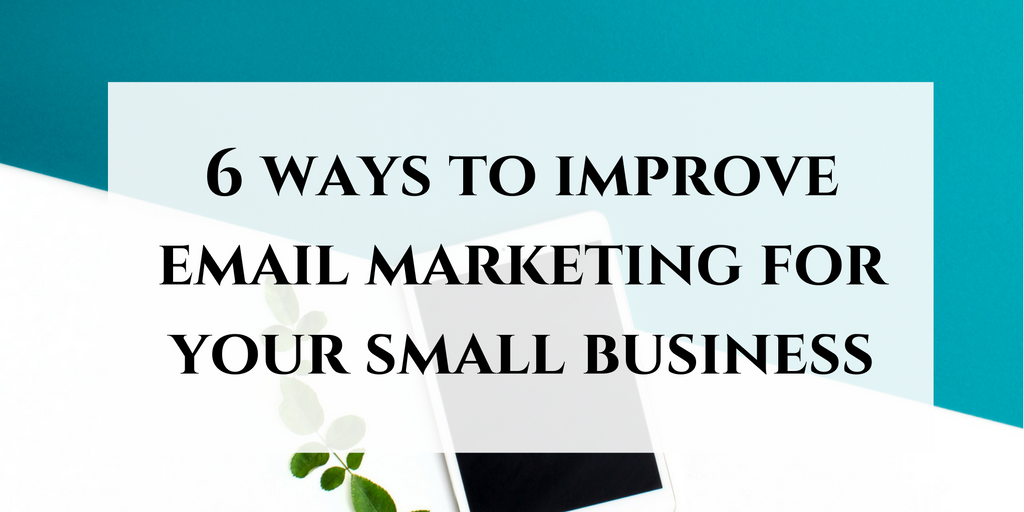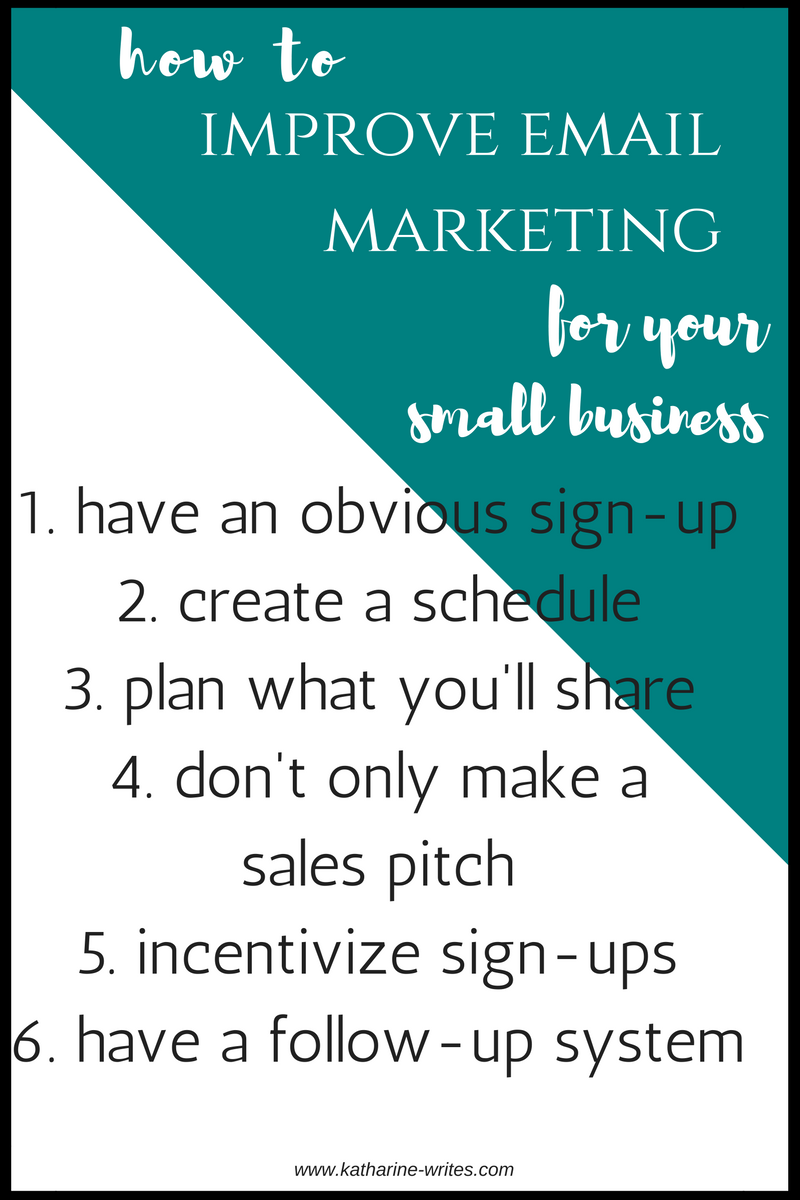
This month we’re talking about that slow time every business experiences between December and January.
Depending on your type of business, your slow-down may happen before or after the holidays. And when it comes, it can leave you worried and anxious. After all, you need your small business to be booming, not lagging.
But instead of wasting your time panicking — because panic never helps anyone — this year, I encourage you to do something different.
Use the slow time to improve your business structures, fix what isn’t working, and check off those little things that have been lingering on your to-do list all year.
Last week I shared some tips for improving your website to prepare for the new year.
This week, we’re tackling something that every small business needs but very few are using effectively: email marketing.

1. Do you have an obvious email sign up on your website?
Obviously, if you want to use email effectively to market your small business, you need to have an email sign-up form on your website.
Odds are, you’ve got that taken care of.
But where is it?
Is your sign-up form tucked into your footer? Only on your contact page? A single line in a sidebar that only shows up when someone is looking at your blog?
You won’t get visitors’ emails if you don’t make the place to sign up obvious. So don’t be afraid to put it out there in multiple places.
At the top of your website. In the sidebar. As a pop-up. At the start or end of blog posts. With product notifications.
The more places you have an obvious sign-up bar, the more emails you will collect.
You might also like: 11 Statistics You Should Know About Email Marketing
Now, that doesn’t mean you should place your sign-up form all over your website willy-nilly.
You still need to be thoughtful, to think about what customers are looking at and how best to catch their attention in a trustworthy, appropriate manner.
But creating an email sign-up and making it difficult to find isn’t doing your business any favors.
You need a sign-up form. And you need to put it where everyone will see it.
2. Do you have a schedule for emailing your list?
It’s too easy (I say from experience) to encourage people to sign-up for your email list and then never send them anything again.
You email them that first time they sign-up. And then a few months later when you have a new product launching. Maybe midway through the year when you write a blog post you’re particularly proud of. Then three times in a month, out of the blue, only to have multiple people unsubscribe because they can’t remember who you are.
Consistency is key for email marketing. And a schedule is key to consistency.
You might also like: How to Turn Your Blog Into a Stellar Marketing Tool
You don’t have to email your list all the time.
But you do need to email them regularly, in a predictable manner, if you want to build a relationship between them and your business.
That might mean weekly or monthly. It might mean every time you have a sale or when you publish a new blog post.
When you email your list depends on what makes the most sense for your business, as well as what you are reasonably able to commit to.
The key is that, no matter how frequently you decide to get in touch, you do so on a regular, predictable schedule that your subscribers come to know and expect.
3. Do you have a plan for what you share via email?
One of the main reasons my clients cite for not making use of their email list is that they don’t know what to share.
Should they copy their blog posts? Send out a newsletter of completely original content? Only email when there’s a sale or a promo code?
What should they even write in an email anyway?
Much like the schedule you settle on, what you share will depend on your business.
BUT you’ll feel much more confident about what you write — and waste a lot less time trying to decide what to write — if you already have a plan in place.
You might also like: The Key to Successful Email Sales
You might decide to send out a monthly newsletter with original content, or a weekly one that links to the blog posts you’ve published that week.
You might share a round-up of products or services that your customers will find valuable.
You might put together a promotional email campaign in the two months leading up to the launch of a new product.
Whatever you decide to share, plan it out ahead of time. Write it in as part of your schedule.
Be as consistent with your content as you are with your timing so (again) subscribers know what to expect from the moment they sign up.
4. When was the last time you shared something that wasn’t a sales pitch?
Letting subscribers know when you have a sale going on, offering them promo codes, or launching new products are all excellent uses of email marketing.
But they aren’t the only use you should be making of your email list.
As a small business, one of your best marketing tools is the relationship you build with your customers. The personal feelings they have toward your brand.
If all they ever see from you in their inboxes is “buy buy buy,” well… that doesn’t go a long way toward building a relationship, does it?
You might also like: Low-Cost Marketing With the Internet
If the only emails you ever send have a sales pitch in them, it’s time to start thinking about other content you can share.
Can you create an exclusive newsletter? Link to popular blog posts? Share articles from your industry? Include a video or funny clip?
Think of your email marketing as a chance to connect with your subscribers on a deeper level than just a sales pitch.
After all, they’ve taken the first step by inviting you into their inbox. It’s your job to make their invitation worthwhile.
5. Do you incentivize email sign ups?
People are wary of giving out their email addresses.
This shouldn’t be surprising — we’re all overwhelmed by our inboxes these days. It’s hard enough to keep track of emails from friends and family, never mind deal with the flood of emails from brands who want us to shop their new sale, share a discount code with a friend, or check out their new ebook.
Now, you know your email list provides actual value. But before becoming a subscriber, visitors to your website have no way of actually knowing that.
You have to convince visitors to sign up by offering something valuable in return.
That might be a free ebook, a course, access to an exclusive Facebook group, or a resource list that will help them.
You might also like: 10 Awesome Tools for Growing Your Small Business
It might be a coupon, an offer of free shipping, or a discounted service.
What you offer will depend on your business and your customers. The important thing is that you offer something.
Customers need a reason to hand over their email address. It’s your job to create an incentive that makes it worth their while.
6. Do you have a follow up system in place with email?
Right after visitors sign up for your email list is when they are most interested in you and invested in your business.
You are first and foremost in their mind, they are excited about what you have to offer, and they want to hear from you.
They just told you they want to hear from you by giving you their email!
So take advantage of that by creating a system to follow up.
Not all right away. But they shouldn’t get your welcome email and then nothing else personal at all!
One of the best ways to use email marketing is with an autoresponder series that reaches out to new subscribers over the first several weeks that they are on your list.
You can create these emails and put them in place to be sent automatically with most email management systems. Once you have them set, they will continue marketing your business to your most interested subscribers — your newest subscribers — without you constantly needing to create and schedule new emails.
Of course, writing an autoresponder series takes time. That’s why it’s a perfect activity for the slow time at the end of the year.
Once you have you autoresponders up and running, you’ll be on your way to connecting with and profiting from new subscribers in the new year.

Leave a Reply